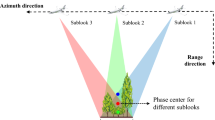Abstract
By Interferometric Synthectic Aperture Radar (InSAR), during the Shuttle Radar Topography Mission (SRTM) height models have been generated, covering the earth surface from 56° south to 60.25° north. With the exception of small gaps in steep parts, dry sand deserts and water surfaces, the free available US C-band data cover the earth surface from 56° south to 60.25° north completely while the X-band data, distributed by the DLR (German Aerospace Center), cover it only partially. The C-band and X-band radar cannot penetrate the vegetation because of the short wavelength. Therefore, the height models are not Digital Elevation Models (DEM) representing bare Earth surface without any details, they are Digital Surface Models (DSM) representing the visible surface including vegetation and buildings. In the area of Zonguldak, Turkey, C-band and X-band DSMs are available and have been analysed in cooperation between Zonguldak Karaelmas University (ZKU) and Leibniz University of Hannover. The digitized contour lines from the 1:25,000 scale topographic maps and also a more precise height model derived directly from large scale photogrammetric mapping are used as reference height models.
The terrain inclination influences the accuracy strongly, but also the directions of the inclination in relation to the radar view direction, the aspects, are important. Independent from the aspects, the analysed results do have root mean square differences against the reference data fitting very well to the Koppe formula SZ=a+b*tan α. The analyses are made separately for open and forest areas, with clear accuracy differences between both. Also, the analysis of X-band separately for three sub-areas is done and the positive effect of double observation to the accuracy has been clearly determined. The C-band data are only available with a spacing of 3 arcsec, corresponding to 92m × 70m, while the X-band data do have a spacing of 1 arcsec. This is important for the interpolation in the mountainous test area. The accuracy of the height points is approximately the same for the C- and the X-band data. But the C-band data which have three times larger spacing than Xband data, do not include the same morphological information. While C-band data contain very generalised contour lines X-band data have quite more details depending on 1 arcsec point spacing. The differential DEMs have been generated, separately, for displaying the differences between SRTM height models and reference DEMs of the test field.
Similar content being viewed by others
References
Bamler R (1999) The SRTM Mission: A World Wide 30m Resolution DEM from SAR Interferometry in 11 Days. Photogrammetric Week, Wichmann Verlag, Heidelberg, Germany, 1999, pp 145–154
Büyüksalih G and Jacobsen K (2004) Generation and Validation of High Resolution Space Image DEMs. ASPRS 2004 Annual Conference “Mountains of Data-Peak Decisions, Denver, Colorado, USA, 2004, p. 11; CD
Heipke C, Koch A and Lohmann P (2002) Analysis of SRTM DTM-Methodology and Practical Results. ISPRS Comission IV Syposium in Ottawa, Canada, July 2002, 12 p, CD
Jacobsen K (2001) Manual of Program System BLUH. Institute for Photogrammetry and GeoInformation, Leibniz University of Hannover, Germany. September 2001. pp522
Kocak G, Buyuksalih G and Oruç M (2005) Accuracy Assessment of Interferometric Digital Elevation Models Derived from the Shuttle Radar Topography Mission X- and C-band Data in a Test Area with Rolling Topography and Moderate Forest Cover. Optical Engineering 44:1–7
Linder W (2002) Programme Description LISA. Module Basis Version 3.0 Update, November 2002
Roth A, Eineder M, Rabus B, Mikusch E and Schättler B (2001) SRTM/X-SAR: products and processing. facility, IEEE Geoscience and Remote Sensing. Symposium (IGARSS’01), Sidney, Australia, July 2001, pp 745–747
Schreirer G (1993) SAR Geocoding: Data and Systems, Karlsruhe: Wichmann. ISBN: 3-87907-247-7 präzis druck, Karlsruhe, Germany. 435p
Sefercik UG (2006) Accuracy Assessment of Digital Elevation Models Derived from Shuttle Radar Topography Mission (SRTM). Master of Science Thesis. Leibniz University of Hannover, Germany
Sefercik UG and Jacobsen K (2006) Analysis of SRTM Height Models. Fifth Turkish-German Geodetic Days, Berlin, Germany, March 2006, 6 p., CD
URL-1, 2008, http://edcsgs9.cr.usgs.gov/pub/data/srtm/
Author information
Authors and Affiliations
Corresponding author
About this article
Cite this article
Sefercik, U.G., Alkan, M. Advanced analysis of differences between C and X bands using SRTM data for mountainous topography. J Indian Soc Remote Sens 37, 335–349 (2009). https://doi.org/10.1007/s12524-009-0044-4
Received:
Accepted:
Published:
Issue Date:
DOI: https://doi.org/10.1007/s12524-009-0044-4




